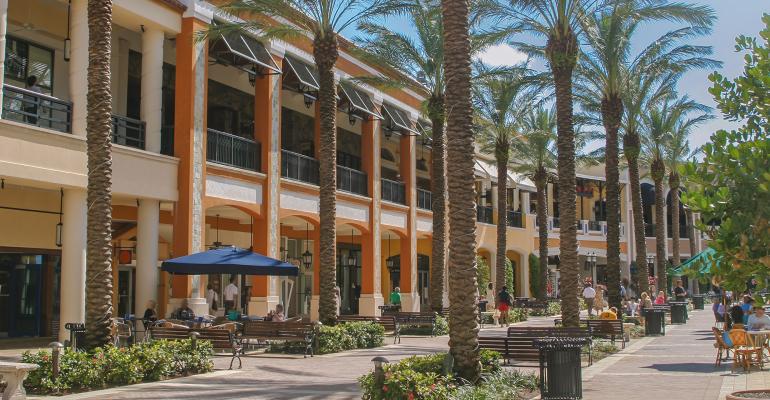Open-air shopping centers have benefited from the pandemic, with many retailers moving from enclosed properties to the open-air format, according to Atlanta-based Chris Decoufle, a senior member with the capital markets retail team at real estate services firm CBRE.
Open-air centers provided retailers the ability to remain open even during the depth of the pandemic and offer shoopers a safer, socially distanced shopping experience, Decoufle says. They were also able to accommodate new or expanded uses, such as space for outdoor dining and curbside pick-up of purchased merchandise, takeout food and groceries ordered online.
Plus, in addition to featuring a diversified tenant mix that can range from grocery stores to coffee shops to fitness centers and medical office providers, open-air centers can now also serve as “last mile” distribution centers for e-commerce operators like Amazon.
In a business where tenant sales predict current rents and future cashflows, Decouflé says that open-air centers are out-performing enclosed malls, as consumers visit them twice as often and spend about three time at them as much per visit.
As a result, investors of all types, from pension funds and REITs to family offices and high-net-worth investors, are increasingly attracted to open-air retail centers as the properties are experiencing a high sales volume. And with cap rates in the mid-5 to high-8 percent range, they offer attractive returns and one of the lowest risk profiles of any property type in today’s markets, Decoufle notes. “Investors are seeing an unleveraged internal rate of return in the 6.0 to 8.5 percent range, depending on risk on the table and upside.”
The opportunity for open-air shopping centers to transition to a mix of uses is an added attraction for investors. “Depending on the location, the ability to add density to an open-air center is now one of the top 10 attributes investors look for because it unlocks additional value,” Decouflé says. “Beyond rental and tenant growth, open-air retail can accommodate density for other uses, including office, multifamily and hotel, and it supports and enhances e-commerce.”
The evolution of open-air retail centers to a mix of uses began prior to the arrival of COVID-19, as a strategy to create built-in foot traffic for retailers and a walkable, amenity-rich environment for apartment dwellers and office users.
For example, Australian retail developer Westfield Corp. in 2019 completed construction of a 23-story, 300-unit multifamily tower adjacent to the 1.3-million-sq.-ft. Westfield UTC, an open-air regional shopping destination in San Diego’s affluent La Jolla/University City neighborhood. Office users, including CBRE, are also located in the center, which underwent a $600-million redevelopment and expansion at that time.
The pandemic is accelerating and expanding this trend of adding diversified uses to retail centers in primary and secondary markets across the country, including the incorporation of new uses by grocery-anchored shopping centers, according to Alexander Levy, a senior consultant with CoStar Advisory Services.
Last week, for example, during a call announcing Kimco Realty’s $4 billion acquisition of Weingarten Realty, a developer/operator of grocery-anchored retail centers, the REITs’ executives discussed plans to add non-retail components to new developments, with a particular focus on multifamily.
Kimco’s Signature Series centers already have a mix of uses, but the retail giant has announced that in light of consumer preferences since the onset of the pandemic, it is stepping up its development and redevelopment efforts in top urban markets nationwide. This program will include the addition of about 10,000 multifamily units and hotel components to promote a “live, work, play environment” that benefits retail tenants and the communities they serve, according to Kimco’s website.
Noting that the addition of non-retail uses was previously limited primarily to regional malls and lifestyle centers, Levy says the trend of transitioning grocery-anchored centers to mixed use is becoming more prevalent.
Investors generally like grocery-anchored centers because they’re very stable and resilient during recessions, Levy says. Plus, as “essential retail,” these centers remained open throughout the pandemic. The transition to include mixed uses adds even more value for investors, as Levy notes, “Mixed-use increases population density that leads to more potential shoppers, creates a synergy that definitely bolsters retail, and all the property types (in the project) see a rent premium bump.”
According to Decoufle, the rent premiums for office space and apartments adjacent to a quality open-air retail center average about 20 percent. “People want to live and work next to cool retail,” he says, suggesting that it creates a sense of place and walkable, urban-style experience that may also encourage additional development in the surrounding community.
Multifamily and office space are the two most common additions to grocery-anchored shopping centers, according to Levy. But other alternative uses may include condominiums, seniors housing, medical office and hotels. He cites two grocery-anchored centers currently undergoing redevelopment to mixed use as examples.
The aging Brodie Oaks Shopping Center in South Austin, which is anchored by a Sprouts Farmers Market, is undergoing a $1-billion redevelopment and expansion to create a mixed-used district on 36.7 acres that will include 1,600 residential units and 1.1 million sq. ft. of office space, restaurants, retail and a hotel, as well as 13.7 acres of open space.
Levy believes the transition of grocery-anchored shopping centers to mixed-use projects make especially good sense in the suburbs, which the pandemic has made more appealing to both millennials beginning to raise families and potentially employers seeking office space near to where their employees live.





